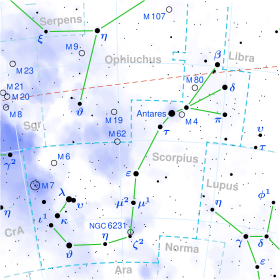Epsilon Scorpii
| Observation data Epoch J2000 Equinox J2000 | |
|---|---|
| Constellation | Scorpius |
| Right ascension | 16h 50m 09.8s[1] |
| Declination | –34° 17′ 36″[1] |
| Apparent magnitude (V) | +2.310[2] (2.24 - 2.35)[3]) |
| Characteristics | |
| Spectral type | K1 III[4] |
| U−B color index | +1.147[2] |
| B−V color index | +1.150[2] |
| Variable type | suspected[3] |
| Astrometry | |
| Radial velocity (Rv) | –2.5[5] km/s |
| Proper motion ( | RA: –614.85[1] mas/yr Dec.: –255.98[1] mas/yr |
| Parallax ( | 51.19 ± 0.22 mas[1] |
| Distance | 63.7 ± 0.3 ly (19.54 ± 0.08 pc) |
| Absolute magnitude (MV) | 0.78 ± 0.04[6] |
| Details | |
| Mass | 1.31[7] M☉ |
| Radius | 12.6[8] R☉ |
| Luminosity | 60[7] L☉ |
| Surface gravity (log g) | 2.34[7] cgs |
| Temperature | 4,560[9] K |
| Metallicity [Fe/H] | –0.17[9] dex |
| Rotational velocity (v sin i) | 2.6 ± 0.5[10] km/s |
| Age | 3.92[7] Gyr |
| Other designations | |
| Database references | |
| SIMBAD | data |
Epsilon Scorpii (
Epsilon Scorpii has a stellar classification of K1 III,[4] which indicates it has exhausted the supply of hydrogen at its core and evolved into a giant star. The interferometry-measured angular diameter of this star, after correcting for limb darkening, is 5.99 ± 0.06 mas,[13] which, at its estimated distance, equates to a physical radius of nearly 13 times the radius of the Sun.[8] Presently it is generating energy through the nuclear fusion of helium at its core, which, considering the star's composition, places it along an evolutionary branch termed the red clump.[14] The star's outer atmosphere has an effective temperature of 4,560 K,[9] giving it the orange hue of a cool K-type star.
Nomenclature
[edit]The star bore the traditional name Larawag in the culture of the Wardaman people of the Northern territory of Australia,[16] meaning clear sighting.[17] In 2016, the I
Patrick Moore introduced the name Wei as Chinese name for this star.[19] However, this seems to be a misreading, as Chinese
In culture
[edit]Epsilon Scorpii appears on the flag of Brazil, symbolising the state of Ceará.[23]
References
[edit]- ^ a b c d e f van Leeuwen, F. (November 2007), "Validation of the new Hipparcos reduction", Astronomy and Astrophysics, 474 (2): 653–664, arXiv:0708.1752, Bibcode:2007A&A...474..653V, doi:10.1051/0004-6361:20078357, S2CID 18759600
- ^ a b c d Gutierrez-Moreno, Adelina; Moreno, Hugo (June 1968), "A photometric investigation of the Scorpio-Centaurus association", Astrophysical Journal Supplement, 15: 459, Bibcode:1968ApJS...15..459G, doi:10.1086/190168
- ^ a b c Samus, N. N.; Durlevich, O. V.; et al. (2009). "VizieR Online Data Catalog: General Catalogue of Variable Stars (Samus+ 2007–2013)". VizieR On-line Data Catalog: B/GCVS. Originally Published in: 2009yCat....102025S. 1: 02025. Bibcode:2009yCat....102025S.
- ^ a b Gray, R. O.; et al. (July 2006), "Contributions to the Nearby Stars (NStars) Project: spectroscopy of stars earlier than M0 within 40 pc-The Southern Sample", The Astronomical Journal, 132 (1): 161–170, arXiv:astro-ph/0603770, Bibcode:2006AJ....132..161G, doi:10.1086/504637, S2CID 119476992
- ^ Wielen, R.; et al. (1999), "Sixth Catalogue of Fundamental Stars (FK6). Part I. Basic fundamental stars with direct solutions", Veroeffentlichungen des Astronomischen Rechen-Instituts Heidelberg, 35 (35), Astronomisches Rechen-Institut Heidelberg: 1, Bibcode:1999VeARI..35....1W
- ^ a b Schroeder, K.-P.; Huensch, M.; Schmitt, J. H. M. M. (July 1988), "X-ray activity and evolutionary status of late-type giants", Astronomy and Astrophysics, 335: 591–595, Bibcode:1998A&A...335..591S
- ^ a b c d Luck, R. Earle (2015-09-01). "Abundances in the Local Region. I. G and K Giants". The Astronomical Journal. 150: 88. arXiv:1507.01466. doi:10.1088/0004-6256/150/3/88. ISSN 0004-6256. Epsilon Scorpii's database entries at VizieR: [1] [2]
- ^ a b Lang, Kenneth R. (2006), Astrophysical formulae, Astronomy and astrophysics library, vol. 1 (3rd ed.), Birkhäuser, ISBN 3-540-29692-1. The radius (R*) is given by:
- ^ a b c McWilliam, Andrew (December 1990), "High-resolution spectroscopic survey of 671 GK giants", Astrophysical Journal Supplement Series, 74: 1075–1128, Bibcode:1990ApJS...74.1075M, doi:10.1086/191527
- ^ Carney, Bruce W.; et al. (March 2008), "Rotation and Macroturbulence in Metal-Poor Field Red Giant and Red Horizontal Branch Stars", The Astronomical Journal, 135 (3): 892–906, arXiv:0711.4984, Bibcode:2008AJ....135..892C, doi:10.1088/0004-6256/135/3/892, S2CID 2756572
- ^ "eps Sco". SIMBAD. Centre de données astronomiques de Strasbourg. Retrieved 2012-02-23.
- ^ a b "Naming Stars". IAU.org. Retrieved 16 December 2017.
- ^ Richichi, A.; Percheron, I.; Khristoforova, M. (February 2005), "CHARM2: An updated Catalog of High Angular Resolution Measurements", Astronomy and Astrophysics, 431 (2): 773–777, Bibcode:2005A&A...431..773R, doi:10.1051/0004-6361:20042039
- ^ a b Adelman, Saul J. (2001), "On the Photometric Variability of Red Clump Giants", Baltic Astronomy, 10 (4): 593–597, Bibcode:2001BaltA..10..593A, doi:10.1515/astro-2001-0404
- ^ Gondoin, P. (December 1999), "Evolution of X-ray activity and rotation on G-K giants", Astronomy and Astrophysics, 352: 217–227, Bibcode:1999A&A...352..217G
- ^ "I
AU Approves 86 New Star Names From Around the World" (Press release). IAU.org. 11 December 2017. - ^ "I
AU Working Group on Star Names (WGSN)" (Press release). IAU.org. - ^ "I
AU Working Group on Star Names (WGSN)". Retrieved 22 May 2016. - ^ Moore, P. (1983), The Guinness Book of Astronomy: Facts (2nd ed.), Middlesex, UK: Guinness Superlatives Limited, p. 242
- ^ (in Chinese)
中國 星座 神話 , written by陳 久金 . Published by台灣 書房 出版 有限 公司 , 2005, ISBN 978-986-7332-25-7. - ^ (in Chinese)
香港 太 空 館 -研究 資源 -亮 星 中 英 對照 表 Archived 2008-10-25 at the Wayback Machine, Hong Kong Space Museum. Accessed on line November 23, 2010. - ^ Ridpath, Ian, Star Tales.
- ^ "Astronomy of the Brazilian Flag". FOTW Flags Of The World website.


